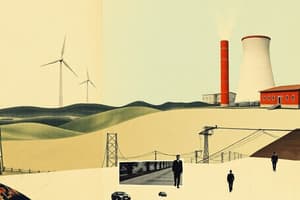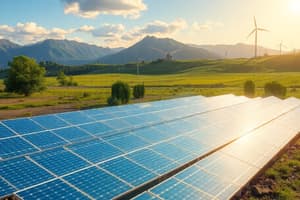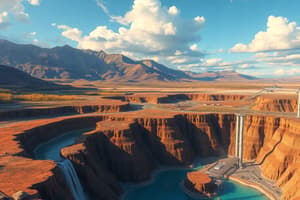Podcast
Questions and Answers
What percentage of the global installed capacity does Volcanic Geothermal represent?
What percentage of the global installed capacity does Volcanic Geothermal represent?
- 96% (correct)
- 4%
- 0%
- 50%
Enhanced Geothermal Systems (EGS) currently have a significant portion of global installed capacity.
Enhanced Geothermal Systems (EGS) currently have a significant portion of global installed capacity.
False (B)
What is the primary substance used in the fracking fluid for geothermal stimulation?
What is the primary substance used in the fracking fluid for geothermal stimulation?
water
Geothermal stimulation is also known as __________.
Geothermal stimulation is also known as __________.
Match the geothermal types with their corresponding global installed capacity percentage:
Match the geothermal types with their corresponding global installed capacity percentage:
What is the approximate temperature gradient found in the Earth's crust per kilometer?
What is the approximate temperature gradient found in the Earth's crust per kilometer?
Geothermal power locations are typically away from tectonic plates.
Geothermal power locations are typically away from tectonic plates.
What is the estimated global geothermal electricity capacity as of 2013?
What is the estimated global geothermal electricity capacity as of 2013?
Geothermal energy is primarily generated from the heat flux driven by _______ in the Earth's crust.
Geothermal energy is primarily generated from the heat flux driven by _______ in the Earth's crust.
Match the following geothermal characteristics with their descriptions:
Match the following geothermal characteristics with their descriptions:
What temperature is considered necessary for a geothermal power plant to operate using dry or superheated steam?
What temperature is considered necessary for a geothermal power plant to operate using dry or superheated steam?
The emissions from geothermal plants include higher levels of sulfur dioxide (SO2) compared to conventional fossil fuel plants.
The emissions from geothermal plants include higher levels of sulfur dioxide (SO2) compared to conventional fossil fuel plants.
What are two environmental issues associated with the operation of geothermal power plants?
What are two environmental issues associated with the operation of geothermal power plants?
In a flash geothermal power plant, impurities are concentrated into _____ after processing.
In a flash geothermal power plant, impurities are concentrated into _____ after processing.
Match the following geothermal plant components with their functions:
Match the following geothermal plant components with their functions:
What is a common consequence of direct cycle geothermal power plant operations?
What is a common consequence of direct cycle geothermal power plant operations?
Geothermal reservoirs can be classified as renewable resources regardless of how they are managed.
Geothermal reservoirs can be classified as renewable resources regardless of how they are managed.
The geothermal reservoirs in Northern California are being _____ at a faster rate than they can replenish.
The geothermal reservoirs in Northern California are being _____ at a faster rate than they can replenish.
Flashcards
Dry/Superheated Geothermal Plant
Dry/Superheated Geothermal Plant
A geothermal power plant where the hot water from the reservoir is superheated to steam and directly used to drive turbines.
Double Flash Geothermal Plant
Double Flash Geothermal Plant
A geothermal power plant that uses a series of flash separators to extract steam from hot water in stages, increasing efficiency.
Geothermal Environmental Effects: Off Gases
Geothermal Environmental Effects: Off Gases
Geothermal plants release off gases containing H2S, SO2, CO2, NOx, and Radon, although at lower levels compared to conventional fossil plants.
Geothermal Environmental Issues: Impurities
Geothermal Environmental Issues: Impurities
Signup and view all the flashcards
Geothermal Environmental Issues: Re-Injection
Geothermal Environmental Issues: Re-Injection
Signup and view all the flashcards
Geothermal Environmental Effects: Induced Seismicity
Geothermal Environmental Effects: Induced Seismicity
Signup and view all the flashcards
Geothermal Heat Draw
Geothermal Heat Draw
Signup and view all the flashcards
Future of Geothermal: Deep Reservoirs
Future of Geothermal: Deep Reservoirs
Signup and view all the flashcards
Enhanced Geothermal System (EGS)
Enhanced Geothermal System (EGS)
Signup and view all the flashcards
Hot Sedimentary Aquifer (HSA)
Hot Sedimentary Aquifer (HSA)
Signup and view all the flashcards
Volcanic Geothermal
Volcanic Geothermal
Signup and view all the flashcards
Geothermal Stimulation
Geothermal Stimulation
Signup and view all the flashcards
Hydraulic Fracturing (Fracking)
Hydraulic Fracturing (Fracking)
Signup and view all the flashcards
Geothermal Heat Flux
Geothermal Heat Flux
Signup and view all the flashcards
Geothermal Gradient
Geothermal Gradient
Signup and view all the flashcards
Suitable Geothermal Locations
Suitable Geothermal Locations
Signup and view all the flashcards
Geothermal Power Capacity
Geothermal Power Capacity
Signup and view all the flashcards
Geothermal Power Plant Locations
Geothermal Power Plant Locations
Signup and view all the flashcards
Study Notes
Renewable Energy Sources
- Renewable energy sources rely on energy from the natural environment, not finite resources, making them effectively infinite.
- Renewables typically exhibit ubiquity (widespread availability), low power density (slow rate of energy extraction), and an intermittent nature (fluctuating energy fluxes).
- Solar energy, wind power, and geothermal energy (except for tidal/geothermal) are derived from the sun's energy. The sun heats the atmosphere unevenly, driving wind patterns.
- Geothermal energy is heat from Earth's radioactive core and crust.
- Tidal energy is created by the moon's gravitational pull.
Renewable Energy Technologies
- Hydro power includes conventional hydroelectric dams, tidal barrages, wave power, and pumped storage.
- Wind power is generated by turbines, and it includes onshore and offshore installations.
- Solar power encompasses photovoltaic cells, collectors, and solar thermal technologies.
- Geothermal technologies include binary cycle power plants, which use heat from hot rocks to produce electricity.
- Biomass includes landfill gas collection, which harnesses the biogas created by decomposing waste and geothermal technologies which use heat from deep underground. Hydrogen and Fuel cells are discussed along with steam methane reforming and water electrolysis.
Typical Power Densities of Renewable Technologies
- A table details the typical power densities for various renewable technologies, including solar photovoltaic, hydroelectric, wind, geothermal, biomass, ocean tidal, and ocean wave energy.
Installed Capacity Costs (2010)
- A graph displays the estimated levelized costs of new electricity generation technologies in 2016, showing costs for different technologies in 2007 dollars per MWh. This data shows costs for various technologies.
U.S. Average Levelized Costs (2007-2016)
- A table presents average levelized costs for different plant types, including various types of coal, natural gas, advanced combined cycles and others, in 2007$/megawatt hour for plants entering service in 2016. This includes data on factors like capacity, levelized capital cost, fixed O&M, etc.
2009 vs 2019 Costs
- A graph compares the installed capacity costs for different technologies in 2009 vs 2019.
2022 Costing
- A table provides estimated levelized costs for different power sources, including new nuclear (SMR), coal, and various gas-based plants. Costs are shown in 2022 Canadian dollars (MWh).
Hydro Power Diagram and Examples
- A diagram illustrates the components of a hydroelectric power station, including a headpond, intake, penstock, powerhouse, turbine, generator, and transformer.
- Examples include Mactaquac Dam, Hoover Dam, and Three Gorges Dam which are all conventional hydroelectric dams.
Tidal Power & Concerns
- A diagram explains tidal barrage operation which uses the tides flowing in and out of a basin to power a turbine.
- There are environmental concerns about tidal turbines in the Bay of Fundy.
Wave Power
- Wave power systems use the kinetic and potential energy of the ocean to generate electricity with a Wells' turbine that turns consistently regardless of the airflow direction.
- The Pelamis wave energy converter is a semi-submerged, articulated structure used for wave energy conversion with hydraulic rams.
Wind Power Description & Components
- Surface winds are created by uneven heating of the Earth via solar radiation, generating density gradients. The Earth's rotation dictates the direction of air flow. Local factors complicate this.
- Early wind turbines were used for applications like grinding, pumping water.
- Horizontal axis wind turbines using cloth sails were developed over time. Modern designs have numerous components including: rotor, hub, gearbox, generator, control unit, and tower. Components like sensors, anemometers, wind vanes, and yaw mechanisms monitor conditions.
- Wind turbine design accounts for continuous variability in wind speed and optimizes for capacity factor in the performance of the wind turbine.
- There are minimum and maximum wind speeds wherein energy extraction is inefficient or impossible. A wind turbine's power depends on its blade size and the cube of the wind speed.
- There is a maximum feasible efficiency (~59%). Actual systems have much lower efficiency.
The Power Coefficient (Cp)
- The power coefficient, also known as the theoretical wind turbine efficiency, Cp is the ratio between the actual power produced by a wind turbine and a theoretical maximum.
- The optimum relationship between upstream and downstream wind speeds is 1:3.
- Actual power coefficients of observed systems are significantly below this optimum theoretical value.
Wind Resource Maps
- Maps show the distribution of wind resources across specific geographic regions helping to locate potential sites for wind farms.
Solar-PV
- Solar-PV plants can produce large amounts of electricity via solar energy (a photoelectric effect).
- Solten project in Spain is an example.
- Solar thermal power plants collect solar energy to generate heat using heliostats (mirrors) to focus sunlight onto a central point for electricity generation. These plants use molten salt for heat storage. Parabolic Trough uses mirrors to focus sunlight onto pipes which then act as the heat exchange fluids to power steam turbines.
- The efficiency of solar energy conversion is typically below 20% which is a major limitation in its use.
Geothermal Energy
- Geothermal energy utilizes heat from the Earth's interior.
- Suitable locations are typically near tectonic plates and active volcanoes. The Pacific "Ring of Fire" is a prime example
- Geothermal energy is usually extracted from high temperature hydro reservoirs or by pumping fluids into the Earth to superheat them and then extracting the resulting steam using pressure differentials.
- Hydraulic fracturing (fracking) is used to increase access to the subterranean reservoir, as it is drilled into and shattered to facilitate access to the pressurized fluid.
Types of Geothermal power plants
- There are three primary types of geothermal power plants (dry/superheated steam, single/double flash, binary cycle plants).
Environmental Impacts of Various Energy Sources
- Environmental impact assessments on land use, visual impact, and other environmental effects are important to understand and weigh in energy decisions. CO2 emissions are higher for non-renewable energy sources.
Studying That Suits You
Use AI to generate personalized quizzes and flashcards to suit your learning preferences.





